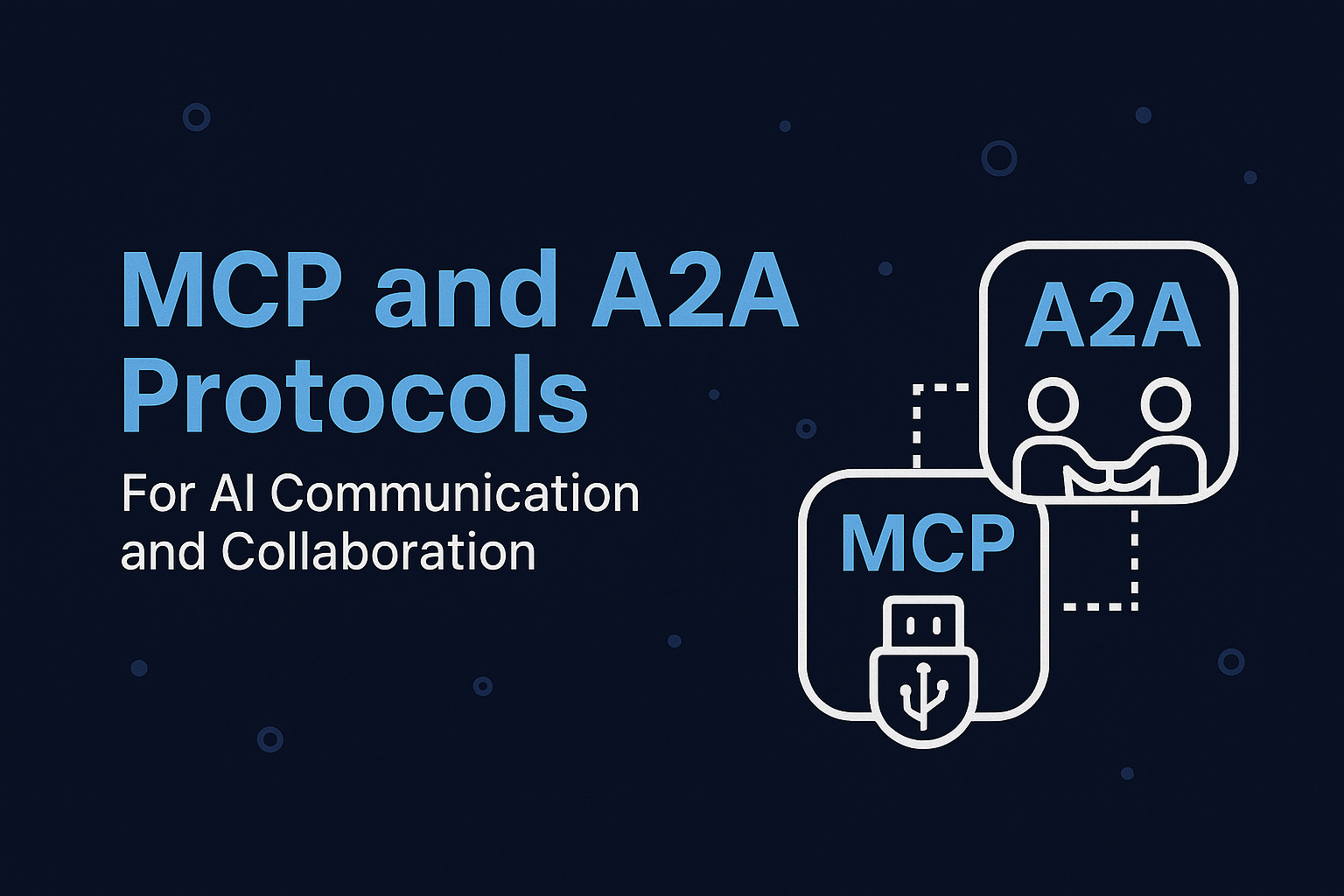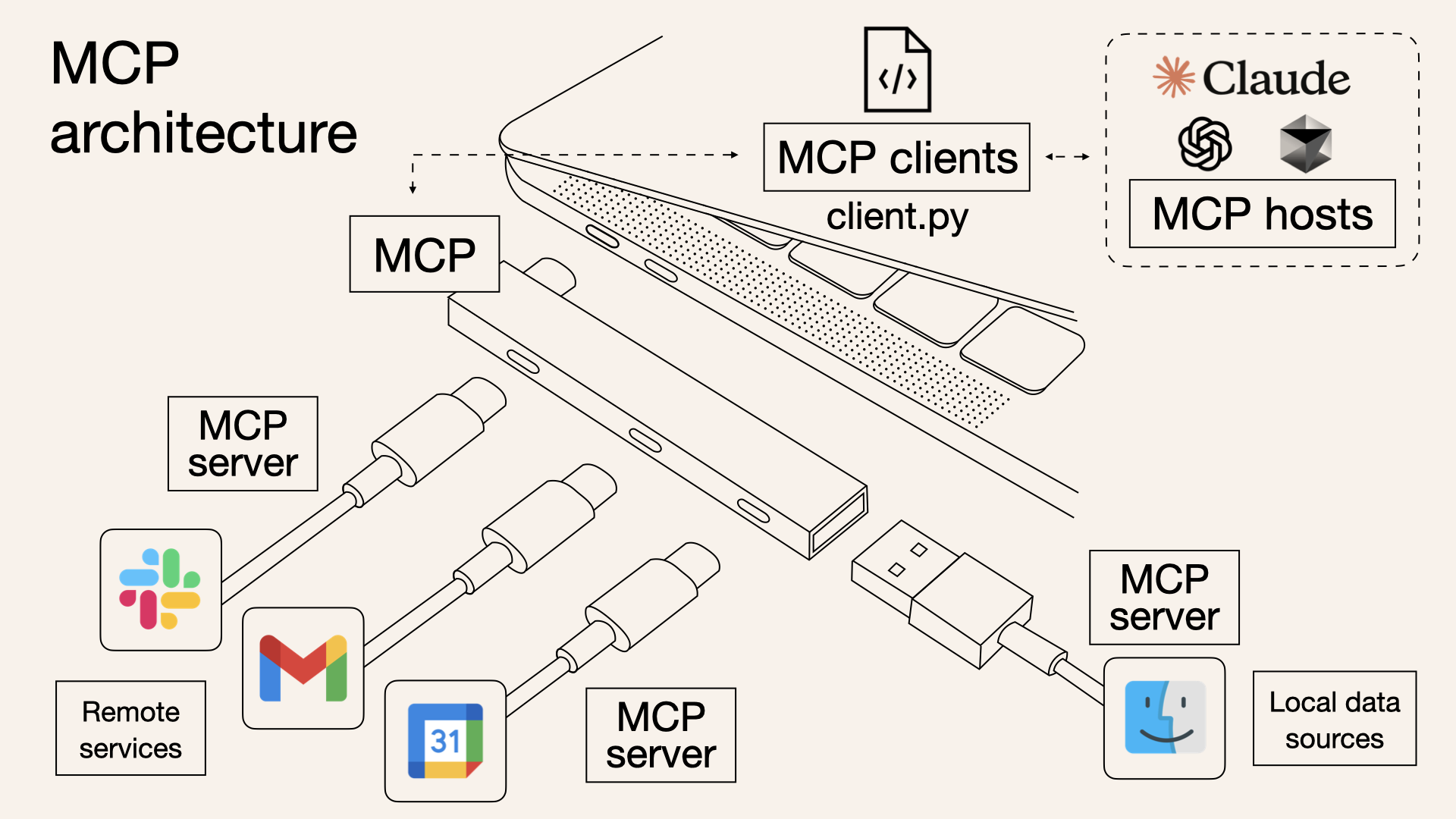
AI Communication Protocols: The Ultimate Guide to MCP and A2A 🤖🔄
Data Scientist and ML Engineer
Model Context Protocol (MCP) and Agent-to-Agent Protocol (A2A) are two complementary standards reshaping how AI systems interact with the world and each other: MCP (by Anthropic) is like a "USB port for AI" that connects an AI agent to external tools, databases, and data sources. It allows AI to access real-time information and perform actions without custom-coding each integration. A2A (by Google) enables different AI agents to discover, communicate with, and collaborate with each other—regardless of who built them or what framework they use.
In today's rapidly evolving AI landscape, we're witnessing models perform increasingly remarkable feats – from writing code and analyzing complex data to engaging in surprisingly human-like conversations. But a significant limitation has been holding these systems back: isolation.
Like brilliant minds locked in separate rooms, AI systems have struggled to access real-time data, specialized tools, and perhaps most importantly, each other. That's now changing with the emergence of two groundbreaking protocols: the Model Context Protocol (MCP) and the Agent-to-Agent Protocol (A2A).
Let's dive into what these protocols mean for the future of AI integration and collaboration! 💡
The Need for AI Communication Standards 🌐
Before we explore these protocols individually, it's worth understanding why they matter. In modern AI applications, complex tasks often require multiple specialized agents or an agent accessing various tools and data sources. Without standard communication protocols, each integration needs custom code, leading to:
- Inconsistent implementation patterns
- Incompatible data formats
- Brittle, hard-to-maintain systems
- Limited collaboration between AI services
As Akash Singh notes, "In enterprise settings, siloed AI agents traditionally cannot share information, limiting their effectiveness." This fragmentation has prompted the development of standardized protocols to enable interoperability and collaboration in AI systems.
Model Context Protocol (MCP): AI's USB Port 🔌
What is MCP? 🤔
Introduced by Anthropic and collaborators in early 2025, the Model Context Protocol (MCP) standardizes how AI applications connect to external tools, data sources, and context.
As Anthropic describes it, MCP is the "USB-C port for AI" – a universal interface that lets you plug an AI model into various resources in a consistent way. It addresses a fundamental challenge: how can an AI agent access real-time information and perform actions without custom-coding each integration?

How MCP Works 🛠️
MCP follows a client-server architecture with these key components:
-
MCP Host 🏠: The AI application or agent that the user interacts with (e.g., a chat interface like Claude Desktop)
-
MCP Client 🔄: A connector component running within the host application, acting as a switchboard managing connections to various MCP servers
-
MCP Server 💻: A lightweight program exposing a specific capability or data source through the MCP interface, such as:
- A file system server (to read/write files)
- A database server (to query records)
- A web API server (to call external services)
-
Local Data Sources 📂: Files, databases, or applications on the user's machine or network
-
Remote Services ☁️: External APIs or online services that MCP servers can connect to
Under the hood, MCP servers expose three main types of capabilities:
- Resources: Data sources the agent can query
- Tools: Actions or functions the agent can invoke
- Prompts: Predefined context blocks that can be inserted when needed
Real-World MCP Use Cases 💼
MCP expands what an AI agent can do by providing controlled access to data and operations:
-
Enhanced Assistants 🗣️: Instead of being limited by a static knowledge cutoff, an MCP-enabled assistant like Claude can pull in up-to-date information and interact with your local files.
-
Smarter Coding Tools 👨💻: AI coding assistants can access code repositories, documentation, or test environments in real-time—providing contextually relevant suggestions.
-
Business Intelligence 📊: Companies can connect internal data sources (like customer databases or HR systems) to AI agents, allowing real-time data retrieval during conversations.
-
Workflow Automation 🔄: MCP servers can perform actions on behalf of the AI—sending emails, filling out forms, or executing complex multi-step workflows.
-
Multi-Model Systems 🧠: MCP can interface with different LLMs, allowing an agent to dynamically choose between models for different tasks.
As one developer put it: "MCP turned our static chatbot into a dynamic assistant that can actually see and use our company data. Game-changer!"
Agent-to-Agent Protocol (A2A): Building AI Teams 🤝
What is A2A? 🤔
While MCP connects AI to tools, the Agent-to-Agent (A2A) Protocol – introduced by Google and industry partners in April 2025 – focuses on enabling different AI agents to interact with each other.
A2A allows independent AI agents (which may themselves be complex systems with their own tools/LLMs) to collaborate on tasks and share information, without custom integration for each pairing.

image reference: https://blog.dailydoseofds.com/p/a-visual-guide-to-agent2agent-a2a
How A2A Works 🛠️
A2A defines both a discovery mechanism and a communication protocol:
-
Agent Card 📇: A JSON metadata file describing an agent's capabilities, skills, and endpoints – think of it as a business card for an agent
-
Discovery Methods 🔍: Ways to find agent cards, including DNS-based discovery, registries, or private discovery networks
-
A2A Server & Client 🔄: Each agent can act as both a server (receiving requests) and a client (sending requests) depending on the interaction
-
Task Objects ✅: The core abstraction in A2A – units of work that one agent asks another to perform, with lifecycle states like submitted, working, input-required, completed, failed, or canceled
-
Real-Time Communication ⚡: Using Server-Sent Events (SSE) for streaming updates during long-running tasks
As Trevor Lasn explains: "A2A serves as a communication framework that enables agents to collaborate, share context, and coordinate their activities – like when a customer service AI needs to talk to an inventory management AI to resolve an issue."
Real-World A2A Use Cases 💼
A2A unlocks exciting possibilities for multi-agent ecosystems:
-
Travel Planning ✈️: A personal assistant might delegate subtasks to specialized agents for flights, hotels, and activities when planning a vacation – each handling their specialty.
-
Enterprise Workflows 🏢: Different departmental AI systems (customer support, inventory, finance) can seamlessly collaborate on cross-functional processes.
-
Cross-Platform Collaboration 🌉: Agents built using different frameworks (LangChain, PaLM API, etc.) can cooperate when specialized expertise is needed.
-
Research & Problem Solving 🔬: A complex research question might be distributed across specialized agents, with a mathematics agent handling calculations while a legal agent checks regulations.
-
Adaptive Systems 🔄: Different agents with different base models can work together, with each handling tasks according to their strengths.
A CTO recently noted: "With A2A, we've moved from having isolated AI tools to having an AI team that can pass tasks around based on expertise. It's how we've always wanted AI to work."
MCP vs. A2A: Different But Complementary 🤝
While both protocols enhance AI capabilities, they serve different purposes:
The Core Distinction 🔍
- MCP: Connects one application to external resources/tools (App → Tool)
- A2A: Connects multiple agents to each other for collaboration (Agent ↔ Agent)
As one expert puts it: "MCP is like giving an agent a toolbelt, whereas A2A is like enabling a team meeting between agents."
Key Differences Table 📋
| Aspect | MCP | A2A |
|---|---|---|
| Primary Focus | Vertical integration (agent-to-tool) | Horizontal integration (agent-to-agent) |
| Architecture | Client-server within a single agent's ecosystem | Distributed peer-to-peer between agents |
| Communication | Often local connections for accessing tools/data | HTTP/JSON-RPC for inter-agent requests |
| Discovery | Usually configuration-based | Dynamic through agent cards and registries |
| Example Use | An agent querying a database | Agents collaborating on a complex workflow |
These protocols aren't rivals – they're designed to be complementary! 🤗 An agent participating in an A2A collaboration might very well use MCP connections to fetch data or execute specific tools needed for its tasks.
The Future of AI Communication Protocols 🔮
Both protocols are evolving rapidly as the community gains experience with them:
MCP's Evolution 📈
- Creation of an official MCP Registry for discovering servers
- Support for multimodal data (images, audio, video)
- Agent Graphs for representing complex topologies
- Improved authentication and user permission models
- More formal, community-driven governance
A2A's Road Ahead 🛣️
- Enhanced security and trust frameworks
- More sophisticated agent discovery mechanisms
- Standard extensions for specialized use cases
- Better framework support across languages
- Performance optimizations for complex workflows
As adoption grows, we'll likely see these protocols become as fundamental to AI systems as HTTP is to the web – the essential plumbing that enables complex, integrated experiences.
Why This Matters for Developers and Businesses 💡
For anyone building or using AI applications, these protocols represent a paradigm shift:
- Reduced Integration Complexity 🧩: Standard interfaces instead of countless custom connections
- Enhanced AI Capabilities 💪: Access to real-time data and specialized functions
- True Multi-Agent Systems 👥: Collaborative AI that can tackle complex problems
- Future-Proofing 🔒: Systems built on standards rather than proprietary interfaces
- Focus on Business Logic 💼: Less time on plumbing, more on valuable AI applications
A software architect recently commented: "Before MCP and A2A, connecting AI systems was like building bridges with different materials and designs every time. Now we have standard blueprints that everyone can follow."
Getting Started with MCP and A2A 🚀
If you're looking to implement these protocols:
For MCP Implementation:
- Explore Anthropic's MCP documentation
- Check out open-source MCP server implementations
- Consider which data sources or tools would benefit your AI application
- Start with simple integrations (file access, web APIs) before complex ones
For A2A Implementation:
- Review Google's A2A protocol specification
- Define your agent's capabilities clearly in an Agent Card
- Implement the A2A server interface for receiving tasks
- Identify partner agents that would complement your agent's abilities
Conclusion: The New Era of Connected AI 🌟
MCP and A2A represent the beginning of a new phase in AI system design – moving from isolated models to interconnected AI ecosystems. Just as internet protocols enabled disparate computers to form the internet, these communication protocols aim to network AI agents and tools into much more powerful systems.
By standardizing how AI connects to tools (MCP) and how agents connect to each other (A2A), we're unlocking possibilities that were previously impractical. The end result will be AI systems that are more contextually aware, more capable, and more collaborative than ever before.
The next time you use an AI assistant that seamlessly accesses your files, retrieves up-to-date information, and coordinates with specialized services to complete complex tasks – you'll be experiencing the power of these protocols in action. Welcome to the future of connected AI! 🚀
References 📚
-
Anthropic. (2025). "Model Context Protocol (MCP) - Anthropic". Retrieved from https://docs.anthropic.com/en/docs/agents-and-tools/mcp
-
Singh, A. (2025, April). "What is A2A (Agent to Agent Protocol)?". Medium. Retrieved from https://medium.com/@akash22675/what-is-a2a-agent-to-agent-protocol-d2325a41633a
-
Lasn, T. (2025). "Understanding Agent2Agent (A2A): A Protocol for LLM Communication". Retrieved from https://www.trevorlasn.com/blog/agent-2-agent-protocol-a2a
-
Logto Blog. (2025). "A2A vs MCP: Two complementary protocols for the emerging agent ecosystem". Retrieved from https://blog.logto.io/a2a-mcp
-
WorkOS Engineering Blog. (2025). "MCP, ACP, A2A, Oh my!". Retrieved from https://workos.com/blog/mcp-acp-a2a-oh-my
-
Model Context Protocol. (2025). "Introduction - Model Context Protocol". Retrieved from https://modelcontextprotocol.io/introduction
-
Model Context Protocol. (2025). "Roadmap - Model Context Protocol". Retrieved from https://modelcontextprotocol.io/development/roadmap
-
MCP Market. (2025). "What is an MCP Server? | Model Context Protocol". Retrieved from https://www.mcpmarket.com/what-is-an-mcp-server
-
Google GitHub. (2025). "Agent2Agent Protocol (A2A)". Retrieved from https://google.github.io/A2A/
-
Reddit. (2025). "Google Announces A2A - Agent to Agent protocol". r/AI_Agents. Retrieved from https://www.reddit.com/r/AI_Agents/comments/1jvbfe8/google_announces_a2a_agent

